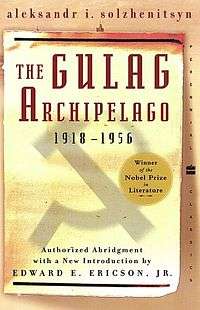
The Gulag Archipelago is Solzhenitsyn's masterwork, a vast canvas of camps, prisons, transit centres and secret police, of informers and spies and interrogators and also of heroism, a Stalinist anti-world at the heart of the Soviet Union where the key to survival lay not in hope but in despair. The work is based on the testimony of some two hundred survivors, and on the recollection of Solzhenitsyn's own eleven years in labour camps and exile. It is both a thoroughly researched document and a feat of literary and imaginative power.
The three-volume book is a narrative relying on eyewitness testimony and primary research material, as well as the author's own experiences as a prisoner in a gulag labor camp. Written between 1958 and 1968, it was published in the West in 1973, thereafter circulating in samizdat (underground publication) form in the Soviet Union until its official publication in 1989.
Structurally, the text is made up of seven sections divided (in most printed editions) into three volumes: parts 1–2, parts 3–4, and parts 5–7. At one level, the Gulag Archipelago traces the history of the system of forced labour camps that existed in the Soviet Union from 1918 to 1956, starting with V.I. Lenin's original decrees shortly after the October Revolution establishing the legal and practical framework for a series of camps where political prisoners and ordinary criminals would be sentenced to forced labour. It describes and discusses the waves of purges, assembling the show trials in context of the development of the greater Gulag system with particular attention to the legal and bureaucratic development.
The legal and historical narrative ends in 1956, the time of Nikita Khrushchev's Secret Speech at the 20th Party Congress of 1956 denouncing Stalin's personality cult, his autocratic power, and the surveillance that pervaded the Stalin era.
The 1st book here pdf version
The 2nd book here pdf version
The 3rd book here pdf version
Source: https://archive.org